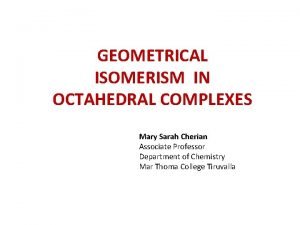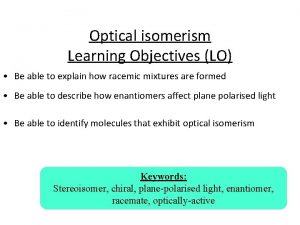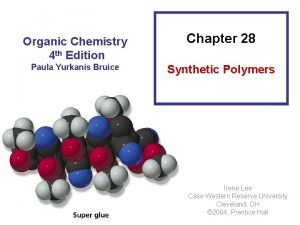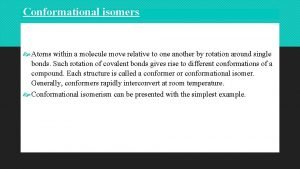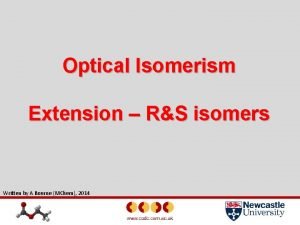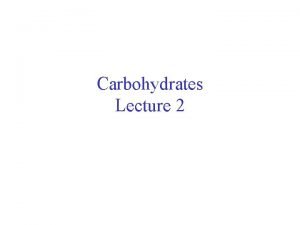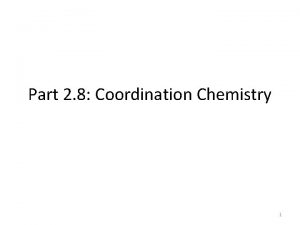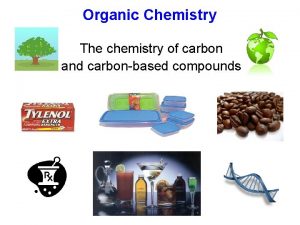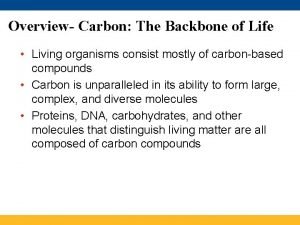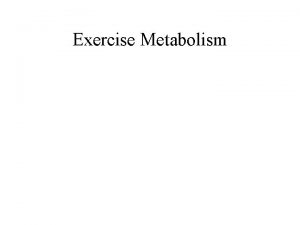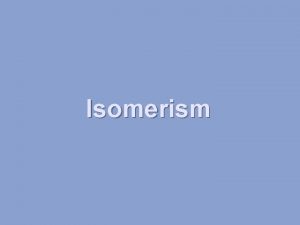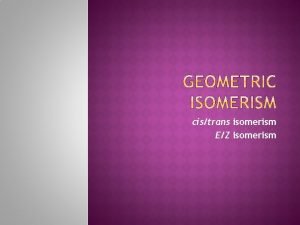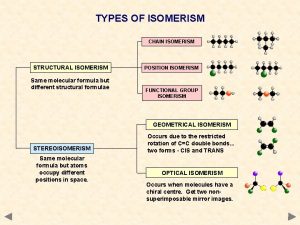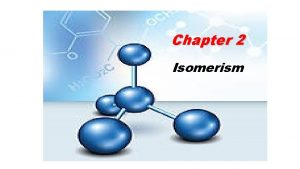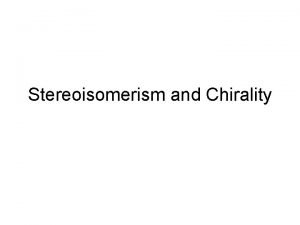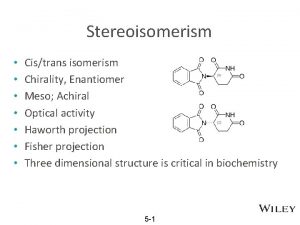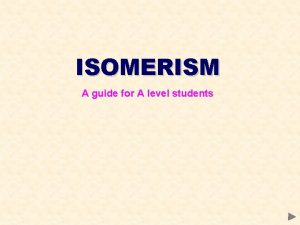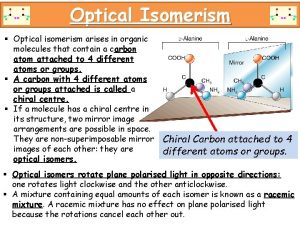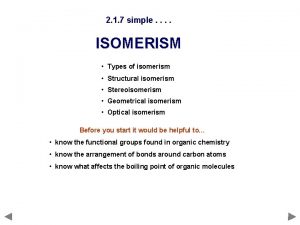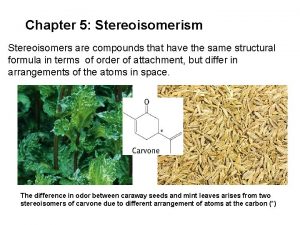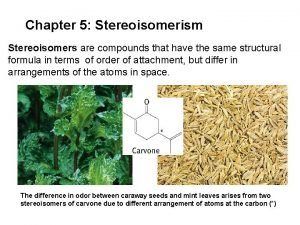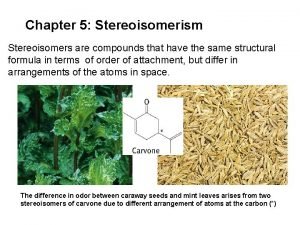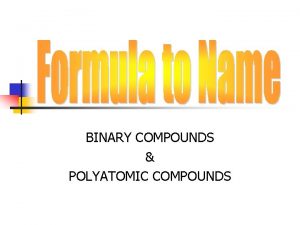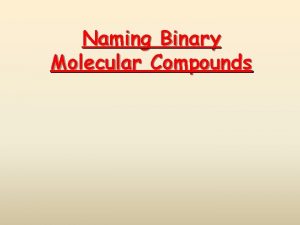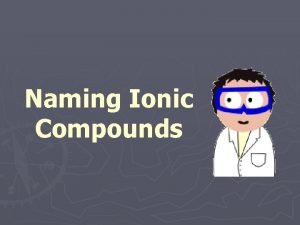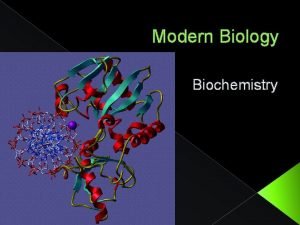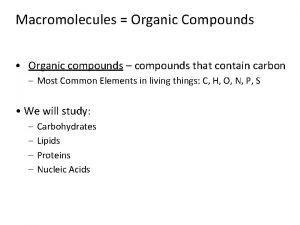Stereoisomerism Isomerism The term isomerism refers to compounds




























- Slides: 28

Stereoisomerism

Isomerism • The term isomerism refers to compounds that have the same molecular formula but different arrangement of atoms. • Structural isomerism- isomers in which atoms and functional groups are attached in different ways. • Stereoisomerism- isomers in which the atoms are attached in the same order, but different in their spatial or three dimensional arrangement.

Isomerism

Stereoisomers • Stereoisomers can be classified as: 1. Conformational isomers- can be interconverted by free rotation about single (sigma) bonds. 2. Configurational isomers- can’t be interconverted, so they exist as separate compounds with distinct properties

Stereoisomers

Configurational Isomers • Two main groups of configurational isomers are:

Cis-Trans and E/Z Isomers






E/Z Isomers • There are cases where E/Z is used instead of cis-trans. • This happens when the carbon atoms in the double bond are bonded to more than two different groups. For example:

E/Z Isomers E/Z naming is based on the rules of priority.



Optical Isomers • Isomers that have different spatial arrangements as a result of there being four different groups tetrahedrally bonded to a single carbon atom, known as a chiral carbon. • These isomers are non-superimposable mirror images of each other and are known as enantiomers. • Optical isomers have the ability to rotate plane-polarized light.

Optical Isomers • A chiral carbon is a carbon atom that is attached to 4 different atoms or groups. • For example: • A chiral atom is also known as asymmetric centre or a stereocentre.

Optical Isomerism

Optical Isomerism • A molecule is considered chiral if its mirror images are nonsuperimposable. • Chiral molecules have no plane of symmetry. • The two mirror images of a chiral molecule are called enantiomers.

Optical Isomerism • A mixture containing equal amounts of the two enantiomers is known as a racemic mixture. • Many molecules have more than once chiral carbon, and so can give rise to different configurations at each chiral carbon. Enantiomers have opposite configurations at EACH chiral centre, which is why molecules are mirror images of each other. • Molecules that have opposite configurations at some, but not all, chiral carbons are known as diastereomers and are not mirror images of each other. • A single chiral centre in a molecule gives rise to two stereoisomers. In general, a molecule with n number of chiral centres has a maximum of 2 n stereoisomers.

Optical Isomers


Properties of Optical Isomers

Optical Activity



Reactivity With Other Chiral Molecules
 Geometrical isomerism in coordination compounds
Geometrical isomerism in coordination compounds Site:slidetodoc.com
Site:slidetodoc.com Ionic and covalent bonds venn diagram
Ionic and covalent bonds venn diagram 2-hydroxypropanenitrile displays optical isomerism
2-hydroxypropanenitrile displays optical isomerism 2 chlorobutane
2 chlorobutane Polymerization isomerism
Polymerization isomerism Propane conformers
Propane conformers Optical isomerism worksheet
Optical isomerism worksheet L and d isomers
L and d isomers Point charge
Point charge Unsaturated carbon compounds
Unsaturated carbon compounds C6h14 chain isomers
C6h14 chain isomers What is structural isomerism
What is structural isomerism What does the term prehistory mean
What does the term prehistory mean The term reconstruction refers to
The term reconstruction refers to Evolutionary theory of motivation
Evolutionary theory of motivation The term “minority majority” refers to the fact that
The term “minority majority” refers to the fact that Data refers to...
Data refers to... Forms of capital structure
Forms of capital structure Oxygen deficit trained vs untrained
Oxygen deficit trained vs untrained Which phrase best describes a food chain
Which phrase best describes a food chain 5 year old tammy mistakenly believes
5 year old tammy mistakenly believes The term corporate culture refers to
The term corporate culture refers to Diversity refers to:
Diversity refers to: The term capacity refers to
The term capacity refers to The term development refers to how people:
The term development refers to how people: Predication is a technical term that refers to
Predication is a technical term that refers to Lashley’s term “engram” refers to ____.
Lashley’s term “engram” refers to ____. Types of communication infrastructure
Types of communication infrastructure
